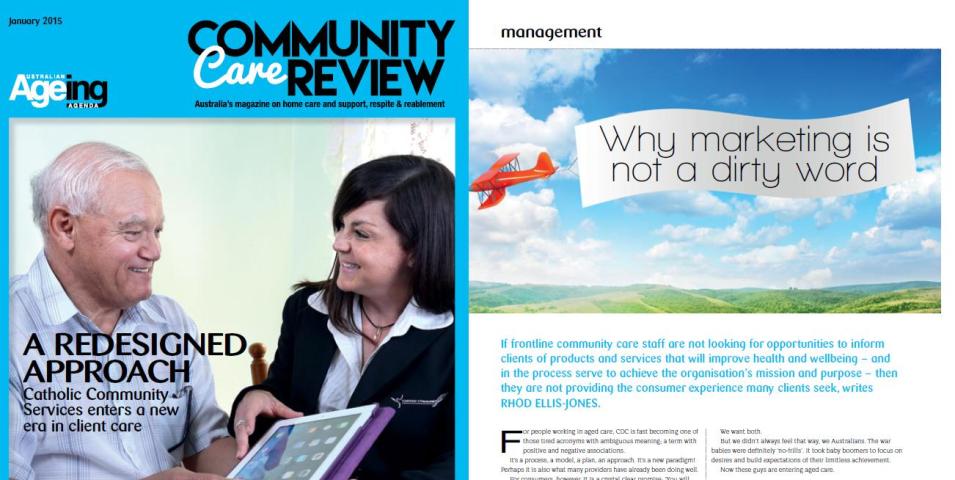
This piece on aged care marketing written by Rhod Ellis-Jones was published in the January 2015 edition of Community Care Review, a new magazine by Australian Ageing Agenda on home care & support, respite and reablement.
If frontline community care staff are not looking for opportunities to inform clients of products and services that will improve health and wellbeing – and in the process serve to achieve the organisation’s mission and purpose – then they are not providing the consumer experience many clients seek, writes RHOD ELLIS-JONES.
For people working in aged care, CDC is fast becoming one of those tired acronyms with ambiguous meaning; a term with positive and negative associations.
It’s a process, a model, a plan, an approach. It’s a new paradigm!
Perhaps it is also what many providers have already been doing well. For consumers, however, it is a crystal clear promise: ‘You will get what you need, the way you like it.’
Providers beware, you are on notice. This is all about me and my expectations being fulfilled. The My Aged Care leaflet said so.
Brand strategists live in this world. Where there is a consumer need but also a ‘like’. The ‘like’ can have absolutely nothing to do with the function of the service. It has everything to do with the emotional context of the interaction: empathy shown to the consumer, the aesthetic impression of the uniform, the carer’s efforts to improve quality of life, and many other aspects of the carer-client relationship.
For example, I may be bandaging your leg with precision but you notice and remember the comment I made about your hair and how a new sofa would be much better for your back.
We all know the stereotype of the matronly nurse focused only on the function not the emotion. Or the vacant telco customer service representative who seems completely ignorant of the functional and emotional context.
We want both.
But we didn’t always feel that way, we Australians. The war babies were definitely ‘no-frills’. It took baby boomers to focus on desires and build expectations of their limitless achievement.
Now these guys are entering aged care.
Market to me.
We need to get over this idea that marketing is a predatory practice; a dirty word.
Marketing ensures people who really need a service find it. It helps consumers choose a provider that is right for them in culture and approach as well as service type.
As the aged care sector becomes increasingly competitive, marketing ensures the company remains among the three provider options that target consumers consider. That’s a business outcome that means a stable job in a business with increasing opportunities.
In a community care context, marketing is not about exerting undue influence on a client. It is no more than finding opportunities for people to achieve health and wellbeing goals.
And that can take many, many forms: a radio for company, a personal alarm device for personal security, a social program for connecting with others at the same life stage and situation, more appropriate clothing, education programs on video.
In the care context, marketing is not selling. It is presenting options supported with information.
Accustomed to achieving lifestyle goals the Boomers – and their informed and tech savvy siblings – are going shopping for the best aged care experience the government’s money, and their own, can buy.
They want choice and a responsive, tailored service beyond the care plan.
Some 39 per cent of Australia’s population is over 50 (7.5 million people). They are either considering care options for themselves, their friends or their parents.
A recent Blaze Boomer Brand Satisfaction survey of 1,100 Australian men and women found that, far from eschewing unsolicited approaches, Boomers welcome them.
A staggering 94 per cent of Boomers think that media and advertising should recognise that “My age group is still interested in buying new things” while 78 per cent agreed that media and advertising should recognise that “I have more financial freedom at my age.”
And let’s remember that superannuation arrived in 1992, 22 years ago. That’s why NAB estimates 60 per cent of people’s income in retirement will be earned after they retire.
If a provider’s nursing and care teams are not looking for opportunities to inform clients of products and services that will improve health and wellbeing – and serve to achieve the company’s mission and purpose – then they are very likely not providing the full consumer experience many clients are seeking.
Think like a consumer.
When the money is in your hands, the decision looms large.
You see faults and it bothers you. You complete mental arithmetic on ‘value’.
It is surprising how everyone, at times, forgets that we are all consumers. We make choices and we notice the difference between great service and bad.
The best advice a company can give to its staff is “think like a consumer.” Whether via structured empathy mapping or simply by asking each client what would make a difference to their lives, we need to get better at standing in the shoes of others and seeing the world through their eyes.
We all repeat a mental and physical pattern of behaviour when weighing up a purchase decision. We consider price but price does not represent value. We look for affinity with our own tastes and values. We weigh up what this decision says about us.
Providers need to:
- Engage regularly and seamlessly
- Address consumer context, emotions and functional needs: empathy map
- Ask who is influencing decisions? What is their path to purchase?
Brand embodied in carer actions.
In service industries, people embody the brand, and creating a brand experience is the key to marketing.
Where there is little or no service differentiation – such as in personal care services – the intangible aspects, the ‘likes’, become more important.
That oft used term ‘add value’ starts to take shape in a client-carer relationship: finding ways to enhance the experience by helping out or referring other services.
Carefully planned, the ‘add-value’ will manifest as new sources of revenue for the responsive organisation.
The deportment of staff says a lot about the company. How to build awareness that this is actually part of the service, not a side show?
Employee engagement is critical to a business or organisation. When team members feel valued, respected, and included, it goes a long way in creating a positive environment. Instilling a sense of pride in your employees begins with instilling a sense of meaningfulness, a sense purpose, a sense of what they are doing as being important.
In our work we find that employees in aged care often do not think they are doing anything out of the ordinary – but they are, and it is worth sharing. They know your products and services in a way that no-one else does, so getting them to share that knowledge is indispensable for developing relationships with clients and their families.
We all know that money, although important, is not what keeps aged care workers in the industry. There is a real passion for improving lives.
They are benevolent, empathetic people and their work weaves through the social fabric of the community in which they work.
In the absence of good news placed by a provider and its staff, media coverage will veer to the negative. But the media loves human stories, particualrly local media, and nothing is more authentic than a positively reinforcing relationship between a carer and resident.
Let’s consider, as a sector and as individual companies, what our employees, residents, families and clients need to see and hear.
What, in their eyes, makes a great company?
Be bold, be creative; tell your story.
Rhod Ellis-Jones is principal of Ellis Jones, a management and public relations agency specialising in aged and community care.

